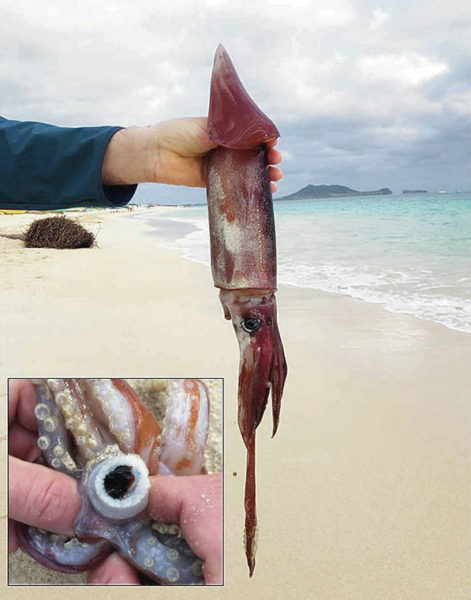Published in the Ocean Watch column, Honolulu Star-Advertiser © Susan Scott
January 25, 2020
Just when I’m feeling discouraged about plastic pollution (Midway can do that to a person), I discover that researchers are working on a solution that sounds like science fiction: squid sucker teeth. Bioengineers at Pennsylvania State University have discovered that the molecules in the teeth that line suckers of some squid species have promising potential for a new, eco-friendly generation of plastic.
But we needn’t worry about the world’s squid populations getting wiped out over it, because no squids are harmed in the making of this material. Using new-generation synthesis, the researchers are able to create polymers identical to those of the squid.
I found this research report while reading up on squid after my friends and I found a large, freshly dead one on a windward beach last week. The squid was not the usual one we see in Hawaii’s inshore waters and coral reefs, a 10- to 14-inch-long creature called the bigfin squid or muhee (Sepioteuthis lessoniana).
 The mystery squid from Lanikai Beach. Inset shows the squid’s teeth that
The mystery squid from Lanikai Beach. Inset shows the squid’s teeth that
line the rim of the tentacles’ suckers, which encircle its black beak.
©2020 Susan Scott
Distinguishing this species is a pair of fins that extend in an oval the length of the body. Our Lanikai squid’s fins, however, were rear triangles, and its muscular body was way too big, about 2 feet long.
The world’s oceans host approximately 300 squid species. Most live in the open ocean, descending into deep water during the day and rising near the surface at night. Nearly everything that can catch a squid, including whales, dolphins, fish and seabirds, thrives on the boneless creatures.
I sometime wonder how squid can survive when so many species eat them. But squid live fast and die young, the life spans of most being only a year or two. Near their lives’ end, mature squid gather in mating frenzies that result in millions of fertilized eggs. That accomplished, the parents die.
Squid, however, are by no means helpless invertebrates. They’re formidable predators. With large eyes for night hunting, and two sharp teeth called a beak, a squid gets bursts of speed by jetting water through the covering of its cylindrical body. Suction cup tentacles, lined with cutting teeth in some species, grasp prey and hold it to the beaky mouth.
It’s in these tentacles’ teeth that Penn State researchers found a protein-based substance with the properties we like in plastic: soft and moldable when heated, hard when cooled. The biodegradable material might compete with, and eventually replace, oil-based plastics.
My guess as to the species we found on Lanikai Beach is that it’s a Humboldt squid, but we’ll find out for sure. My scientist friend who was with me took tissue samples and will do DNA identification in his lab.
As I wait for the official answer, finding that 2019 study about squid sucker teeth cheered me up about plastic pollution. Science might save us yet.